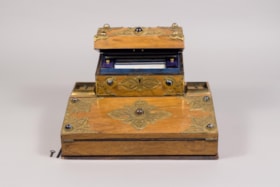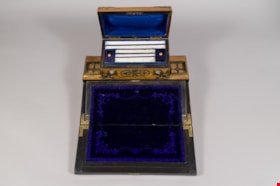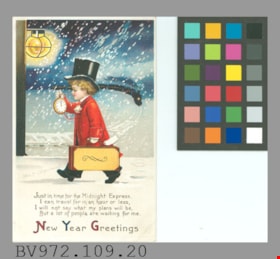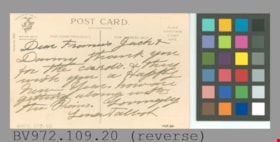Narrow Results By
Person / Organization
- A. MacKenzie and Company Jubilee Store 2
- Aujla, Kehar Singh 1
- Barnet Mill 1
- Bateman, Marianne May 2
- Belcastro, Arlene 1
- The Bollywood Boyz 1
- Bridge Studios 1
- British Columbia Electric Railway Company 12
- British Columbia Ferry Services Incorporated 1
- British Columbia Hydro and Power Authority 1
- British Columbia Provincial Police 2
- Burke, Pat 1
Kapoor Sawmills on fire
https://search.heritageburnaby.ca/link/museumdescription15211
- Repository
- Burnaby Village Museum
- Date
- 14 Jan. 1947 (date of original), copied 2004
- Collection/Fonds
- In the Shadow by the Sea collection
- Description Level
- Item
- Physical Description
- 1 photograph (tiff) : 300 dpi
- Scope and Content
- Photograph of the Kapoor sawmill on fire on January 14, 1947. Photograph is taken from the shore looking west up Burrard Inlet. There is snow covering the ground.
- Repository
- Burnaby Village Museum
- Collection/Fonds
- In the Shadow by the Sea collection
- Description Level
- Item
- Physical Description
- 1 photograph (tiff) : 300 dpi
- Scope and Content
- Photograph of the Kapoor sawmill on fire on January 14, 1947. Photograph is taken from the shore looking west up Burrard Inlet. There is snow covering the ground.
- History
- Kapoor Singh Siddoo was born in 1885 in the Punjab village of Kharaudi, India. Kapoor was one of the pioneer South Asian Canadian Sikhs who immigrated to America in 1906 and onto Canada in 1912. Kapoor first arrived in San Francisco in 1906, along with twenty uneducated men from the Province of Punjab, India. Kapoor was the only one among these men who was educated so acted as their interpreter, manager and accountant. They worked along the Southern Pacific Railway line near Marysville, California, toward Reno and Nevada. Kapoor heard about the beauty of British Columbia and decided to travel to the west coast but times were tough with discrimination against all South Asians in British Columbia. With this information, Kapoor traveled east to Northern Ontario where he tried homesteading for a year but the extreme winter conditions didn’t appeal to him. Kapoor returned to British Columbia after receiving word from South Asian Canadians that they were in need of an educated accountant/manager for a sawmill. In 1923, with the change in immigration laws, Kapoor arranged for his wife, Besant Kaur to emigrate from India. Besant came to Canada accompanied by Kapoor’s older brother. Kapoor and Besant had two daughters, both born in Duncan B.C. Jagdis Kaur Siddoo was born in 1925 and Sarjit Kaur Siddoo was born in 1926. Both of their daughters graduated as doctors from University of Toronto medical school. His career in B.C. began as a lumberman for a large lumber mill on Vancouver Island until 1935. Following this, Kapoor established the Kapoor Lumber Company Limited and operated a mill at Shawnigan Lake before eventually purchasing 45 acres in 1939 of the eastern section of the former Barnet Mill site in Burnaby. He purchased the site from the Municipality of Burnaby under the name of Modern Sawmills Limited since there was a restriction on selling this piece of a property to a non-white person. Eventually the name was changed to Kapoor Sawmills Limited. Kapoor’s company was a financial success but was tragically razed on January 14, 1947 due to a devastating fire. A smaller mill was rebuilt on the site and Kapoor maintained a successful financial operation until 1959. In 1959, Kapoor Siddoo was considered one of Vancouver’s most influential men in the South Asian Community. In this same year, the family set up the Kapoor Singh Siddoo Foundation and with help from his wife and daughters opened a hospital in the Punjab village of Aur. In 1964, Kapoor died in India at the age of 79 years. Kapoor’s younger brother, Tara Singh Siddoo came to Canada from India in 1906 but after suffering discrimination, he returned to India in 1912. Several years later Tara returned to Canada joining Kapoor at a logging mill on Vancouver Island. Lesser shares of the mill were held by Tara and other family members. Tara and his wife, Beant Siddoo lived at Barnet between 1943 and 1945, with their family of five sons, Lakhbeer, Gurdeb, Gurcharn, Baldev, Hardev and three daughters, Harjeet (Sangha), Runjeet (Basi) and Buckshish (Sarai). One of Tara’s responsibilities was to oversee the logging camp and ensure that the logs arrived regularly from Cowichan Bay near Duncan to the Barnet logging mill.
- Subjects
- Industries - Logging/lumber
- Natural Phenomena - Fires
- Natural Phenomena - Snow
- Persons - South Asian Canadians
- Names
- Kapoor Sawmills Limited
- Geographic Access
- Burrard Inlet
- Barnet Marine Park
- Accession Code
- BV019.32.31
- Access Restriction
- No restrictions
- Reproduction Restriction
- May be restricted by third party rights
- Date
- 14 Jan. 1947 (date of original), copied 2004
- Media Type
- Photograph
- Historic Neighbourhood
- Barnet (Historic Neighbourhood)
- Planning Study Area
- Burnaby Mountain Area
- Notes
- Title based on contents of photograph
Images
Knight family photographs
https://search.heritageburnaby.ca/link/archivedescription64501
- Repository
- City of Burnaby Archives
- Date
- 1948-1971
- Collection/Fonds
- Burnaby Historical Society fonds
- Description Level
- File
- Physical Description
- 49 photographs (35 prints : b&w and col. and 14 negatives : b&w)
- Scope and Content
- Photographs of "the Bird Doctor" Virginia Knight and her husband Milton and their properties, avaries, and pets. File also includes the couple's travel photographs, photograph's of Milton's antique clock and watch collection, and images of Lakeview Aviaries in Burnaby.
- Repository
- City of Burnaby Archives
- Date
- 1948-1971
- Collection/Fonds
- Burnaby Historical Society fonds
- Subseries
- Knight family subseries
- Physical Description
- 49 photographs (35 prints : b&w and col. and 14 negatives : b&w)
- Description Level
- File
- Record No.
- 510-001
- Access Restriction
- No restrictions
- Reproduction Restriction
- May be restricted by third party rights
- Accession Number
- BHS1992-53
- Scope and Content
- Photographs of "the Bird Doctor" Virginia Knight and her husband Milton and their properties, avaries, and pets. File also includes the couple's travel photographs, photograph's of Milton's antique clock and watch collection, and images of Lakeview Aviaries in Burnaby.
- Media Type
- Photograph
- Notes
- Title based on contents of photographs
- Stamp on verso of 510-001 reads: "Woodward's Advertising Photography"
- Note on verso of 510-003 reads: "Taken at San Juan Capistrano. The minute you enter the place these pigeons light all over you and they sell you small bags of wheat to feed them." Other notes and date stamp on verso.
- Note on verso of 510-010 reads: "Virgie + Sheila Joan (Easton) Mulliner / New Year's Eve / 1970-71"
- 510-008, 510-009, 510-011, 510-012: Date stamp on verso reads "Jan 12, 1962"
- Note on verso of 510-022 reads: "My little Saw-Whet Owl who was one of my patients. Fully recovered and hand tame."
- 510-024 is five small photographs glued to a black paper album page
- Handwritten notes on recto of 510-032, describing the clocks in the photograph.
- Geographic Access
- Deer Lake
- Street Address
- 5255 Sperling Avenue
- Historic Neighbourhood
- Burnaby Lake (Historic Neighbourhood)
- Planning Study Area
- Burnaby Lake Area
Images
leaflet
https://search.heritageburnaby.ca/link/museumartifact34876
- Repository
- Burnaby Village Museum
- Accession Code
- BV993.10.7
- Description
- Passport to Burnaby - Leaflet -- [1992]. A commemorative leaflet as part of the Burnaby Centennial Celebration. The goal was to promote travel to host centres to receive a stamp as part of a passport. When all stamps were collected the page could be entered into a draw. Participating Host Centres were C.G. Brown Memorial Swimming Pool, Cameron Recreation Centre, Confederation Centre, Burnaby Mountain Golf Course, Burnaby Municipal Hall, Burnaby Village Museum, Bob Prittie Metrotown Branch, The Burnaby Arts Centre, Still Creek Recycling Depot, and Bonsor Recreation Complex. The passport has been stamped for Burnaby Municipal Hall. The leaflet was produced by the Finance Department and the Centennial Committee. The leaflet measures 28cm x 21.5cm.
- Title
- Passport to Burnaby
- Subjects
- Documentary Artifacts
- Documentary Artifacts - Leaflets
- Celebrations
- Celebrations - Centennials
Images
Learnings from the pandemic
https://search.heritageburnaby.ca/link/museumdescription14748
- Repository
- Burnaby Village Museum
- Date
- Aug. 2020
- Collection/Fonds
- Burnaby Village Museum COVID-19 collection
- Description Level
- File
- Physical Description
- 3 photographs (tiff) : col. ; 72 dpi.
- Scope and Content
- File consists of photographs of screenshots taken from an iPhone Apple Notes text application. The photographs consist of a piece of writing reflecting on the learnings of COVID-19 by Yimeng (Jane) Zhao. A transcription of the written work reads: "Before pandemic ¦Synchronization¦ The moment whe…
- Repository
- Burnaby Village Museum
- Collection/Fonds
- Burnaby Village Museum COVID-19 collection
- Description Level
- File
- Physical Description
- 3 photographs (tiff) : col. ; 72 dpi.
- Scope and Content
- File consists of photographs of screenshots taken from an iPhone Apple Notes text application. The photographs consist of a piece of writing reflecting on the learnings of COVID-19 by Yimeng (Jane) Zhao. A transcription of the written work reads: "Before pandemic ¦Synchronization¦ The moment when your local cafe plays the same song as you're listening to on your headphones When you arrive for your date with the girls and end up matching by accident After getting a new lipstick it made you decide to finally make the move (travel to a new place, land your dream job) Posted a similar WeChat moment/Instagram story as your dudes/gals When you walk into the men's washroom by accident then at the guitar class They taught you the song "yellow" during... Learnings 1. Drilling helps you relieve wrists pains especially if you are tech-addict or journal writers 2. Sudden stopping on the car happens often, don't forget the safety belts 3. Never ride with a complete strange driver unless you're with someone you trust 4. Don't pick wild flowers no matter how small they are 5. Put things back to where you found them 6. Your folks are just like children, spending time to listen 7. Slow to anger. Always respect 8. Smile 9. #blackoutTuesday 10. Your index finger can work wonders 11. So can a stylus 12. Try before actually buying/returning 13. Think before speaking/answering 14. Just do it 15. Action speak louder than words 16. Let music speak 17. A picture is worth a thousand words 18. Words can be weapons 19. #createdonthate 20. Do not take anything for granted 21. Family first 22. Don't cry or get angry if it doesn't help the situation 23. Laughing out loud cures mild depressed moods 24. So does exercise 25. And culinary arts 26. Painting/sketching too 27. Journal the things you want to complain, but be grateful for all that comes 28. Pray 29. Used aroma therapy 30. CBT 31. Eye drops are cheesy p"
- Creator
- Zhao, Yimeng (Jane)
- Subjects
- Pandemics - COVID-19
- Accession Code
- BV020.23.1
- Access Restriction
- No restrictions
- Reproduction Restriction
- No known restrictions
- Date
- Aug. 2020
- Media Type
- Photograph
- Notes
- Title based on content of photographs
Images
The Lee Block on Government Street.
https://search.heritageburnaby.ca/link/museumdescription9388
- Repository
- Burnaby Village Museum
- Date
- 1975
- Collection/Fonds
- Way Sang Yuen Wat Kee & Co. fonds
- Description Level
- Item
- Physical Description
- 1 photograph : b&w; 17.5 x 23 cm
- Scope and Content
- Photograph of a three story brick building on a main street. The building has been identified as the Lee Block, 1618-1628 Government Street at the corner of Government as Fisgard in Victoria. One of the business is Bayshor Travel. "Lum Sai Ho Ass'n" written in Chinese characters on the storefront …
- Repository
- Burnaby Village Museum
- Collection/Fonds
- Way Sang Yuen Wat Kee & Co. fonds
- Description Level
- Item
- Physical Description
- 1 photograph : b&w; 17.5 x 23 cm
- Scope and Content
- Photograph of a three story brick building on a main street. The building has been identified as the Lee Block, 1618-1628 Government Street at the corner of Government as Fisgard in Victoria. One of the business is Bayshor Travel. "Lum Sai Ho Ass'n" written in Chinese characters on the storefront of the shop fourth from the left. The front window has some pottery displayed and the address, 1624 . In front of the business a station wagon is parked and there is a someone giving it a ticket. Next to that store is one called "China Commodity /All Products from Peoples Republic of China." The front windows display plates and other pottery.
- Geographic Access
- Victoria
- Accession Code
- BV017.7.198
- Access Restriction
- No restrictions
- Reproduction Restriction
- No known restrictions
- Date
- 1975
- Media Type
- Photograph
- Scan Resolution
- 300
- Scan Date
- 29-Jul-2018
- Scale
- 96
- Notes
- Title based on contents of photograph
Images
Letter from Brigadeer Colin Fox to May Bateman
https://search.heritageburnaby.ca/link/museumdescription15129
- Repository
- Burnaby Village Museum
- Date
- 8 Aug. 1943
- Collection/Fonds
- E.W. Bateman family fonds
- Description Level
- Item
- Physical Description
- 2 p. + envelope
- Scope and Content
- Item consists of a letter written by Colin Rhodes Fox of the Royal Canadian Artillery Service to his aunt Marianne "May" Bateman while serving overseas during World War II. Colin Fox served in the 13th Canadian Field Regiment, 44th Canadian Field Battery. Letter is written on Salvation Army station…
- Repository
- Burnaby Village Museum
- Collection/Fonds
- E.W. Bateman family fonds
- Description Level
- Item
- Physical Description
- 2 p. + envelope
- Scope and Content
- Item consists of a letter written by Colin Rhodes Fox of the Royal Canadian Artillery Service to his aunt Marianne "May" Bateman while serving overseas during World War II. Colin Fox served in the 13th Canadian Field Regiment, 44th Canadian Field Battery. Letter is written on Salvation Army stationery. In his letter, Colin describes his time on leave that he spent in London; tells of how he plans to travel to Scotland on his next leave and letters and parcels that he's received from family members.
- Accession Code
- BV020.27.17
- Access Restriction
- Restricted access
- Reproduction Restriction
- May be restricted by third party rights
- Date
- 8 Aug. 1943
- Media Type
- Textual Record
- Scan Resolution
- 600
- Scan Date
- 10-Feb-2021
- Scale
- 100
- Notes
- Title based on contents of item
- Stationery insignia in red ink on envelope and writing paper reads: logo of "The Salvation Army" / with the Canadian Active Service Forces" + logo of "The Salvation Army" / "Keep in touch with the folks at home" / ON ACTIVE SERVICE / with the / CANADIAN FORCES"
- Address on front of envelope reads: "Miss M. Bateman / 3896 W. 25th Ave. / Vancouver B.C. / Canada"
- Return address on verso of envelope reads: "K 19022 Bdr. C.R.Fox / 44th Fld. Bty. / 13th Fld. Reg't. R.C.A. A.F. / Canadian Army Overseas"
- Stamp in blue ink on outside cover of air mail letter reads: "13 FD. RECT. R.C.A. / OUT GOING MAIL"
- Circular post mark stamp on front of envelope reads: "FIELD POST OFFICE 484 / AU 9 / 43"
- Typewritten note on back of page one reads: "Thought you might like / to read this; will you/ please send it back / as I'll be answering / it one of these days"
Images
Letter from Jesse Love to Dot Love
https://search.heritageburnaby.ca/link/museumdescription3033
- Repository
- Burnaby Village Museum
- Date
- [1910] (date of original), photographed 1979
- Collection/Fonds
- Love family fonds
- Description Level
- Item
- Physical Description
- 1 photograph : b&w print ; 25.4 x 20.2 cm
- Scope and Content
- Photograph of the first page of a two page letter written by Jesse Love to his daughter Martha (Dot) Love. Jesse Love wrote the letter from Toronto to tell his daughter about his travel in Ontario and Quebec. The letter is dated 21 August 1910 on the first page, and the original letter has creases …
- Repository
- Burnaby Village Museum
- Collection/Fonds
- Love family fonds
- Description Level
- Item
- Physical Description
- 1 photograph : b&w print ; 25.4 x 20.2 cm
- Scope and Content
- Photograph of the first page of a two page letter written by Jesse Love to his daughter Martha (Dot) Love. Jesse Love wrote the letter from Toronto to tell his daughter about his travel in Ontario and Quebec. The letter is dated 21 August 1910 on the first page, and the original letter has creases from being folded.
- Accession Code
- HV979.40.4
- Access Restriction
- No restrictions
- Reproduction Restriction
- No known restrictions
- Date
- [1910] (date of original), photographed 1979
- Media Type
- Photograph
- Related Material
- To see the second page of this letter, see HV979.40.5
- Scan Resolution
- 600
- Scan Date
- 2023-09-12
- Notes
- Title based on contents of photograph
Images
Letter from Jesse Love to Dot Love
https://search.heritageburnaby.ca/link/museumdescription3034
- Repository
- Burnaby Village Museum
- Date
- [1910] (date of original), photographed 1979
- Collection/Fonds
- Love family fonds
- Description Level
- Item
- Physical Description
- 1 photograph : b&w print ; 25.5 x 20.2 cm
- Scope and Content
- Photograph documents the second page of a two page letter written by Jesse Love to his daughter Martha (Dot) Love. Jesse Love wrote the letter from Toronto to tell his daughter about his travel in Ontario and Quebec. The letter is dated 21 August 1910 on the first page, and the original letter has …
- Repository
- Burnaby Village Museum
- Collection/Fonds
- Love family fonds
- Description Level
- Item
- Physical Description
- 1 photograph : b&w print ; 25.5 x 20.2 cm
- Scope and Content
- Photograph documents the second page of a two page letter written by Jesse Love to his daughter Martha (Dot) Love. Jesse Love wrote the letter from Toronto to tell his daughter about his travel in Ontario and Quebec. The letter is dated 21 August 1910 on the first page, and the original letter has creases from being folded.
- Accession Code
- HV979.40.5
- Access Restriction
- No restrictions
- Reproduction Restriction
- No known restrictions
- Date
- [1910] (date of original), photographed 1979
- Media Type
- Photograph
- Related Material
- To see the first page of this letter, see HV979.40.4
- Scan Resolution
- 600
- Scan Date
- 2023-09-12
- Notes
- Title based on contents of photograph
Images
Man at saw
https://search.heritageburnaby.ca/link/museumdescription15200
- Repository
- Burnaby Village Museum
- Date
- [194-] (date of original), copied 2004
- Collection/Fonds
- In the Shadow by the Sea collection
- Description Level
- Item
- Physical Description
- 1 photograph (tiff) : 300 dpi
- Scope and Content
- Photograph of an unidentified man standing next to a saw in operation at Kapoor Sawmills Limited. The large saw blade is in motion cutting through large logs.
- Repository
- Burnaby Village Museum
- Collection/Fonds
- In the Shadow by the Sea collection
- Description Level
- Item
- Physical Description
- 1 photograph (tiff) : 300 dpi
- Scope and Content
- Photograph of an unidentified man standing next to a saw in operation at Kapoor Sawmills Limited. The large saw blade is in motion cutting through large logs.
- History
- Kapoor Singh Siddoo was born in 1885 in the Punjab village of Kharaudi, India. Kapoor was one of the pioneer South Asian Canadian Sikhs who immigrated to America in 1906 and onto Canada in 1912. Kapoor first arrived in San Francisco in 1906, along with twenty uneducated men from the Province of Punjab, India. Kapoor was the only one among these men who was educated so acted as their interpreter, manager and accountant. They worked along the Southern Pacific Railway line near Marysville, California, toward Reno and Nevada. Kapoor heard about the beauty of British Columbia and decided to travel to the west coast but times were tough with discrimination against all South Asians in British Columbia. With this information, Kapoor traveled east to Northern Ontario where he tried homesteading for a year but the extreme winter conditions didn’t appeal to him. Kapoor returned to British Columbia after receiving word from South Asian Canadians that they were in need of an educated accountant/manager for a sawmill. In 1923, with the change in immigration laws, Kapoor arranged for his wife, Besant Kaur to emigrate from India. Besant came to Canada accompanied by Kapoor’s older brother. Kapoor and Besant had two daughters, both born in Duncan B.C. Jagdis Kaur Siddoo was born in 1925 and Sarjit Kaur Siddoo was born in 1926. Both of their daughters graduated as doctors from University of Toronto medical school. His career in B.C. began as a lumberman for a large lumber mill on Vancouver Island until 1935. Following this, Kapoor established the Kapoor Lumber Company Limited and operated a mill at Shawnigan Lake before eventually purchasing 45 acres in 1939 of the eastern section of the former Barnet Mill site in Burnaby. He purchased the site from the Municipality of Burnaby under the name of Modern Sawmills Limited since there was a restriction on selling this piece of a property to a non-white person. Eventually the name was changed to Kapoor Sawmills Limited. Kapoor’s company was a financial success but was tragically razed on January 14, 1947 due to a devastating fire. A smaller mill was rebuilt on the site and Kapoor maintained a successful financial operation until 1959. In 1959, Kapoor Siddoo was considered one of Vancouver’s most influential men in the South Asian Community. In this same year, the family set up the Kapoor Singh Siddoo Foundation and with help from his wife and daughters opened a hospital in the Punjab village of Aur. In 1964, Kapoor died in India at the age of 79 years. Kapoor’s younger brother, Tara Singh Siddoo came to Canada from India in 1906 but after suffering discrimination, he returned to India in 1912. Several years later Tara returned to Canada joining Kapoor at a logging mill on Vancouver Island. Lesser shares of the mill were held by Tara and other family members. Tara and his wife, Beant Siddoo lived at Barnet between 1943 and 1945, with their family of five sons, Lakhbeer, Gurdeb, Gurcharn, Baldev, Hardev and three daughters, Harjeet (Sangha), Runjeet (Basi) and Buckshish (Sarai). One of Tara’s responsibilities was to oversee the logging camp and ensure that the logs arrived regularly from Cowichan Bay near Duncan to the Barnet logging mill.
- Names
- Kapoor Sawmills Limited
- Geographic Access
- Burrard Inlet
- Barnet Marine Park
- Accession Code
- BV019.32.21
- Access Restriction
- No restrictions
- Reproduction Restriction
- May be restricted by third party rights
- Date
- [194-] (date of original), copied 2004
- Media Type
- Photograph
- Historic Neighbourhood
- Barnet (Historic Neighbourhood)
- Planning Study Area
- Burnaby Mountain Area
- Notes
- Title based on contents of photograph
Images
map
https://search.heritageburnaby.ca/link/museumartifact91126
- Repository
- Burnaby Village Museum
- Accession Code
- BV011.44.10
- Description
- map brochure; cover on one side reads "VANCOUVER, BRITISH COLUMBIA / CANADA / VISITORS / GUIDE / AND MAP" and the other side reads: "GREATER VANCOUVER / CANADA / MOTEL / HOTEL / GUIDE / TRAVEL BY THE DOGOOD'" and includes the logo for "British Columbia / Motels & Resorts / Trailer Parks / Association" with dogwood in centre. One side of fold-out includes map titled "Guide Map of Greater Vancouver / Woodwards" and includes inset map of Downtown Vancouver and Stanley Park and inset map of Lower Mainland and Fraser Valley Vancouver and Vicinity along with a list of Greater Vanouver Area Motels and Hotels. The other side of the fold-out includes colour adds for tourist sites and amenities in Greater Vancouver including Capilano Suspension bridge; Heritage Village, Burnaby, B.C.; MacMillan Planetarium; Bloedel Conservatory; Grouse Mountain; Gastown; The Ship of the Seven Seas restaurant and Woodwards stores and shopping centres. Map was published in the public interest by Woodward's (Lower Mainland) department stores; B.C. Motels and Resorts Association Branch "C" whose members appear on the map inside.
- Category
- 08. Communication Artifacts
- Classification
- Documentary Artifacts - - Graphic Documents
- Object Term
- Cartograph, Map
- Measurements
- 45.5 x 70 cm folded to 22.5 x 10 cm
- Country Made
- Canada
- Geographic Access
- Vancouver
Images
Maude Holmstrom interview April 1989 - Track 1
https://search.heritageburnaby.ca/link/oralhistory263
- Repository
- City of Burnaby Archives
- Date Range
- 1909-1914
- Length
- 0:07:09
- Summary
- This portion of the recording includes (Lucy) Maude (Goodridge) Holmstrom's memories of first coming to Burnaby with her family, especially her mother and father, and the establishment of the Goodridge's grocery store.
- Repository
- City of Burnaby Archives
- Summary
- This portion of the recording includes (Lucy) Maude (Goodridge) Holmstrom's memories of first coming to Burnaby with her family, especially her mother and father, and the establishment of the Goodridge's grocery store.
- Date Range
- 1909-1914
- Photo Info
- Maude Goodridge Holmstrom (middle row, 4th from right) with her Howard Avenue class, photographed by J.W. Phillips, 1913. Item no. 487-004
- Length
- 0:07:09
- Historic Neighbourhood
- Capitol Hill (Historic Neighbourhood)
- Interviewer
- Johnson, Lou
- Interview Date
- April 1989
- Scope and Content
- Recording is of an interview with (Lucy) Maude (Goodridge) Holmstrom, conducted by her grandniece, Lou Johnson, April 1989. Major themes discussed are: Capitol Hill, early pioneers in Burnaby, Howard Avenue School.
- Biographical Notes
- Lucy Maude "Maude" Goodrige was born on Aprril 13, 1902 at Stanley Place, London, England. She was the eldest child of John Charles Bertram and Lucy (Elston) Goodridge, with four siblings; Alice Victoria, Gwendoline Elston "Gwen", Beatrice Alexandra, and George Edward Goodridge. John and Lucy Goodridge moved their family from Victoria Drive to Burnaby into a one room house on Capitol Hill, built over one year by John himself. At first, the family had to walk to Rosser to get drinking water, wheeling wheelbarrows full of water back home. Later on, John would discover a Grotto of fresh water on their property. When surveyors started showing land, travelling on horseback from Boundary Road to Capitol Hill, Lucy (Elston) Goodridge would offer lemonade and oranges to the thirsty settlers. This gave her the idea to start the first grocery store in the area, at Alpha and Hastings. Kelly Douglas helped the Goodridges stock the store with larger food orders. For smaller quantities, they used Swift and Company downtown. Maude first went to Howard Avenue School with her younger siblings then to the four room school Gilmore Avenue when it opened. Before John Goodridge went off to war in 1914, he handled grocery delivery and restocking using a team of horses. No one else in the family could handle the team, so while he was overseas, Maude would travel down to Swift and Company by streetcar and be forced to wait for a ride home from someone passing by as the stock was too heavy to carry on foot. Later, Maude remembers a Ford dealer coming to teach her how to drive, in effort to get her mother to buy a Ford. It worked. Maude lived at Capitol Hill until 1920. At the time of the depression, she was in California with her first husband, John Joseph Lemire whom she married October 14, 1922 in Vancouver. Gwendoline Elston "Gwen" Goodridge married William Lister of Point Grey, June 27, 1928. Alice Victoria Goodridge married David Augustus Norman September 24, 1929. Lucy Maude "Maude" (Goodridge) later married George William Holmstrom. George William Holmstrom died in 1957. His wife, Lucy Maude "Maude" (Goodridge) Holmstrom died in 1994.
- Total Tracks
- 3
- Total Length
- 0:23:44
- Interviewee Name
- Holmstrom, Lucy Maude "Maude" Goodridge Lemire
- Collection/Fonds
- Burnaby Historical Society fonds
- Subseries
- Oral history subseries
- Media Type
- Sound Recording
- Web Notes
- Interview was digitized in 2010 allowing it to be accessible on Heritage Burnaby. The digitization project was initiated by the Community Heritage Commission with support from City of Burnaby Council and the BC History Digitization Program of the Irving K. Barber Learning Centre, University of British Columbia. It was recognized by the Heritage Society of BC with an award in 2012.
Images
Audio Tracks
Track one of recording of interview with Maude Holmstrom
Track one of recording of interview with Maude Holmstrom
https://search.heritageburnaby.ca/media/hpo/_Data/_Archives_Oral_Histories/_Unrestricted/MSS137-007/MSS137-007_Track_1.mp3Maude Holmstrom interview April 1989 - Track 2
https://search.heritageburnaby.ca/link/oralhistory264
- Repository
- City of Burnaby Archives
- Date Range
- 1910-1914
- Length
- 0:09:45
- Summary
- This portion of the recording includes (Lucy) Maude (Goodridge) Holmstrom's memories of Howard Avenue School and of learning to drive at a very young age.
- Repository
- City of Burnaby Archives
- Summary
- This portion of the recording includes (Lucy) Maude (Goodridge) Holmstrom's memories of Howard Avenue School and of learning to drive at a very young age.
- Date Range
- 1910-1914
- Photo Info
- Maude Goodridge Holmstrom (middle row, 4th from right) with her Howard Avenue class, photographed by J.W. Phillips, 1913. Item no. 487-004
- Length
- 0:09:45
- Names
- Howard Avenue School
- Historic Neighbourhood
- Capitol Hill (Historic Neighbourhood)
- Interviewer
- Johnson, Lou
- Interview Date
- April 1989
- Scope and Content
- Recording is of an interview with (Lucy) Maude (Goodridge) Holmstrom, conducted by her grandniece, Lou Johnson, April 1989. Major themes discussed are: Capitol Hill, early pioneers in Burnaby, Howard Avenue School.
- Biographical Notes
- Lucy Maude "Maude" Goodrige was born on Aprril 13, 1902 at Stanley Place, London, England. She was the eldest child of John Charles Bertram and Lucy (Elston) Goodridge, with four siblings; Alice Victoria, Gwendoline Elston "Gwen", Beatrice Alexandra, and George Edward Goodridge. John and Lucy Goodridge moved their family from Victoria Drive to Burnaby into a one room house on Capitol Hill, built over one year by John himself. At first, the family had to walk to Rosser to get drinking water, wheeling wheelbarrows full of water back home. Later on, John would discover a Grotto of fresh water on their property. When surveyors started showing land, travelling on horseback from Boundary Road to Capitol Hill, Lucy (Elston) Goodridge would offer lemonade and oranges to the thirsty settlers. This gave her the idea to start the first grocery store in the area, at Alpha and Hastings. Kelly Douglas helped the Goodridges stock the store with larger food orders. For smaller quantities, they used Swift and Company downtown. Maude first went to Howard Avenue School with her younger siblings then to the four room school Gilmore Avenue when it opened. Before John Goodridge went off to war in 1914, he handled grocery delivery and restocking using a team of horses. No one else in the family could handle the team, so while he was overseas, Maude would travel down to Swift and Company by streetcar and be forced to wait for a ride home from someone passing by as the stock was too heavy to carry on foot. Later, Maude remembers a Ford dealer coming to teach her how to drive, in effort to get her mother to buy a Ford. It worked. Maude lived at Capitol Hill until 1920. At the time of the depression, she was in California with her first husband, John Joseph Lemire whom she married October 14, 1922 in Vancouver. Gwendoline Elston "Gwen" Goodridge married William Lister of Point Grey, June 27, 1928. Alice Victoria Goodridge married David Augustus Norman September 24, 1929. Lucy Maude "Maude" (Goodridge) later married George William Holmstrom. George William Holmstrom died in 1957. His wife, Lucy Maude "Maude" (Goodridge) Holmstrom died in 1994.
- Total Tracks
- 3
- Total Length
- 0:23:44
- Interviewee Name
- Holmstrom, Lucy Maude "Maude" Goodridge Lemire
- Collection/Fonds
- Burnaby Historical Society fonds
- Subseries
- Oral history subseries
- Media Type
- Sound Recording
- Web Notes
- Interview was digitized in 2010 allowing it to be accessible on Heritage Burnaby. The digitization project was initiated by the Community Heritage Commission with support from City of Burnaby Council and the BC History Digitization Program of the Irving K. Barber Learning Centre, University of British Columbia. It was recognized by the Heritage Society of BC with an award in 2012.
Images
Audio Tracks
Track two of recording of interview with Maude Holmstrom
Track two of recording of interview with Maude Holmstrom
https://search.heritageburnaby.ca/media/hpo/_Data/_Archives_Oral_Histories/_Unrestricted/MSS137-007/MSS137-007_Track_2.mp3Maude Holmstrom interview April 1989 - Track 3
https://search.heritageburnaby.ca/link/oralhistory265
- Repository
- City of Burnaby Archives
- Date Range
- 1909-1929
- Length
- 0:06:51
- Summary
- This portion of the recording includes (Lucy) Maude (Goodridge) Holmstrom's memories of her family life during the early days of Burnaby.
- Repository
- City of Burnaby Archives
- Summary
- This portion of the recording includes (Lucy) Maude (Goodridge) Holmstrom's memories of her family life during the early days of Burnaby.
- Date Range
- 1909-1929
- Photo Info
- Maude Goodridge Holmstrom (middle row, 4th from right) with her Howard Avenue class, photographed by J.W. Phillips, 1913. Item no. 487-004
- Length
- 0:06:51
- Historic Neighbourhood
- Capitol Hill (Historic Neighbourhood)
- Interviewer
- Johnson, Lou
- Interview Date
- April 1989
- Scope and Content
- Recording is of an interview with (Lucy) Maude (Goodridge) Holmstrom, conducted by her grandniece, Lou Johnson, April 1989. Major themes discussed are: Capitol Hill, early pioneers in Burnaby, Howard Avenue School.
- Biographical Notes
- Lucy Maude "Maude" Goodrige was born on Aprril 13, 1902 at Stanley Place, London, England. She was the eldest child of John Charles Bertram and Lucy (Elston) Goodridge, with four siblings; Alice Victoria, Gwendoline Elston "Gwen", Beatrice Alexandra, and George Edward Goodridge. John and Lucy Goodridge moved their family from Victoria Drive to Burnaby into a one room house on Capitol Hill, built over one year by John himself. At first, the family had to walk to Rosser to get drinking water, wheeling wheelbarrows full of water back home. Later on, John would discover a Grotto of fresh water on their property. When surveyors started showing land, travelling on horseback from Boundary Road to Capitol Hill, Lucy (Elston) Goodridge would offer lemonade and oranges to the thirsty settlers. This gave her the idea to start the first grocery store in the area, at Alpha and Hastings. Kelly Douglas helped the Goodridges stock the store with larger food orders. For smaller quantities, they used Swift and Company downtown. Maude first went to Howard Avenue School with her younger siblings then to the four room school Gilmore Avenue when it opened. Before John Goodridge went off to war in 1914, he handled grocery delivery and restocking using a team of horses. No one else in the family could handle the team, so while he was overseas, Maude would travel down to Swift and Company by streetcar and be forced to wait for a ride home from someone passing by as the stock was too heavy to carry on foot. Later, Maude remembers a Ford dealer coming to teach her how to drive, in effort to get her mother to buy a Ford. It worked. Maude lived at Capitol Hill until 1920. At the time of the depression, she was in California with her first husband, John Joseph Lemire whom she married October 14, 1922 in Vancouver. Gwendoline Elston "Gwen" Goodridge married William Lister of Point Grey, June 27, 1928. Alice Victoria Goodridge married David Augustus Norman September 24, 1929. Lucy Maude "Maude" (Goodridge) later married George William Holmstrom. George William Holmstrom died in 1957. His wife, Lucy Maude "Maude" (Goodridge) Holmstrom died in 1994.
- Total Tracks
- 3
- Total Length
- 0:23:44
- Interviewee Name
- Holmstrom, Lucy Maude "Maude" Goodridge Lemire
- Collection/Fonds
- Burnaby Historical Society fonds
- Subseries
- Oral history subseries
- Media Type
- Sound Recording
- Web Notes
- Interview was digitized in 2010 allowing it to be accessible on Heritage Burnaby. The digitization project was initiated by the Community Heritage Commission with support from City of Burnaby Council and the BC History Digitization Program of the Irving K. Barber Learning Centre, University of British Columbia. It was recognized by the Heritage Society of BC with an award in 2012.
Images
Audio Tracks
Track three of recording of interview with Maude Holmstrom
Track three of recording of interview with Maude Holmstrom
https://search.heritageburnaby.ca/media/hpo/_Data/_Archives_Oral_Histories/_Unrestricted/MSS137-007/MSS137-007_Track_3.mp3Mayo Manhas and Kapoor Singh Siddoo in mill office
https://search.heritageburnaby.ca/link/museumdescription15182
- Repository
- Burnaby Village Museum
- Date
- [194-] (date of original), copied 2004
- Collection/Fonds
- In the Shadow by the Sea collection
- Description Level
- Item
- Physical Description
- 1 photograph (tiff) : 300 dpi
- Scope and Content
- Photograph of Mayo Manhas (right) and Kapoor Singh Siddoo (left) in a mill office looking over a map Vancouver Island with timber areas.
- Repository
- Burnaby Village Museum
- Collection/Fonds
- In the Shadow by the Sea collection
- Description Level
- Item
- Physical Description
- 1 photograph (tiff) : 300 dpi
- Scope and Content
- Photograph of Mayo Manhas (right) and Kapoor Singh Siddoo (left) in a mill office looking over a map Vancouver Island with timber areas.
- History
- Kapoor Singh Siddoo was born in 1885 in the Punjab village of Kharaudi, India. Kapoor was one of the pioneer South Asian Canadian Sikhs who immigrated to America in 1906 and onto Canada in 1912. Kapoor first arrived in San Francisco in 1906, along with twenty uneducated men from the Province of Punjab, India. Kapoor was the only one among these men who was educated so acted as their interpreter, manager and accountant. They worked along the Southern Pacific Railway line near Marysville, California, toward Reno and Nevada. Kapoor heard about the beauty of British Columbia and decided to travel to the west coast but times were tough with discrimination against all South Asians in British Columbia. With this information, Kapoor traveled east to Northern Ontario where he tried homesteading for a year but the extreme winter conditions didn’t appeal to him. Kapoor returned to British Columbia after receiving word from South Asian Canadians that they were in need of an educated accountant/manager for a sawmill. In 1923, with the change in immigration laws, Kapoor arranged for his wife, Besant Kaur to emigrate from India. Besant came to Canada accompanied by Kapoor’s older brother. Kapoor and Besant had two daughters, both born in Duncan B.C. Jagdis Kaur Siddoo was born in 1925 and Sarjit Kaur Siddoo was born in 1926. Both of their daughters graduated as doctors from University of Toronto medical school. His career in B.C. began as a lumberman for a large lumber mill on Vancouver Island until 1935. Following this, Kapoor established the Kapoor Lumber Company Limited and operated a mill at Shawnigan Lake before eventually purchasing 45 acres in 1939 of the eastern section of the former Barnet Mill site in Burnaby. He purchased the site from the Municipality of Burnaby under the name of Modern Sawmills Limited since there was a restriction on selling this piece of a property to a non-white person. Eventually the name was changed to Kapoor Sawmills Limited. Kapoor’s company was a financial success but was tragically razed on January 14, 1947 due to a devastating fire. A smaller mill was rebuilt on the site and Kapoor maintained a successful financial operation until 1959. In 1959, Kapoor Siddoo was considered one of Vancouver’s most influential men in the South Asian Community. In this same year, the family set up the Kapoor Singh Siddoo Foundation and with help from his wife and daughters opened a hospital in the Punjab village of Aur. In 1964, Kapoor died in India at the age of 79 years. Kapoor’s younger brother, Tara Singh Siddoo came to Canada from India in 1906 but after suffering discrimination, he returned to India in 1912. Several years later Tara returned to Canada joining Kapoor at a logging mill on Vancouver Island. Lesser shares of the mill were held by Tara and other family members. Tara and his wife, Beant Siddoo lived at Barnet between 1943 and 1945, with their family of five sons, Lakhbeer, Gurdeb, Gurcharn, Baldev, Hardev and three daughters, Harjeet (Sangha), Runjeet (Basi) and Buckshish (Sarai). One of Tara’s responsibilities was to oversee the logging camp and ensure that the logs arrived regularly from Cowichan Bay near Duncan to the Barnet logging mill.
- Subjects
- Persons - South Asian Canadians
- Accession Code
- BV019.32.3
- Access Restriction
- No restrictions
- Reproduction Restriction
- May be restricted by third party rights
- Date
- [194-] (date of original), copied 2004
- Media Type
- Photograph
- Historic Neighbourhood
- Barnet (Historic Neighbourhood)
- Planning Study Area
- Burnaby Mountain Area
- Notes
- Title based on contents of photograph
- see page 65 in the book "In the Shadow by the Sea - recollections of Burnaby's Barnet Village". Caption with photograph reads: "Mr. Mayo Manhas and Mr. Kapoor Siddoo in the mill office looking over a map of timber areas. c. 1940s"
Images
McLean family summer activities
https://search.heritageburnaby.ca/link/archivedescription85422
- Repository
- City of Burnaby Archives
- Date
- 1963
- Collection/Fonds
- George H.F. McLean fonds
- Description Level
- Item
- Physical Description
- 1 digital file ( 4 min., 15 sec ) : digital , col., si.
- Scope and Content
- Item consists of one silent colour film segment providing glimpses of the McLean family playing games of shuffle board and horse shoes outside and their travels with a travel trailer. It is followed by footage of the McLean's daughter,Teresa, at play inside and outside with other children and the f…
- Repository
- City of Burnaby Archives
- Date
- 1963
- Collection/Fonds
- George H.F. McLean fonds
- Physical Description
- 1 digital file ( 4 min., 15 sec ) : digital , col., si.
- Description Level
- Item
- Record No.
- 567-001-7
- Access Restriction
- No restrictions
- Reproduction Restriction
- May be restricted by third party rights
- Accession Number
- 2014-03
- Scope and Content
- Item consists of one silent colour film segment providing glimpses of the McLean family playing games of shuffle board and horse shoes outside and their travels with a travel trailer. It is followed by footage of the McLean's daughter,Teresa, at play inside and outside with other children and the family in a campground, at a beach, boating and kayaking.
- Media Type
- Moving Images
- Photographer
- McLean, George H.F.
- Notes
- Title based on content of film
- Films originated in an 8mm format and were digitized by George McLean before being donated to the CBA
Images
Video
McLean family summer activities, 1963
McLean family summer activities, 1963
https://search.heritageburnaby.ca/media/hpo/_Data/_Archives_Moving_Images/_Unrestricted/567-001-7.m4vMen on green chain
https://search.heritageburnaby.ca/link/museumdescription15201
- Repository
- Burnaby Village Museum
- Date
- [194-] (date of original), copied 2004
- Collection/Fonds
- In the Shadow by the Sea collection
- Description Level
- Item
- Physical Description
- 1 photograph (tiff) : 300 dpi
- Scope and Content
- Photograph of two unidentified men working on the green chain at Kapoor Sawmills Limited. One of the men is Sikh.
- Repository
- Burnaby Village Museum
- Collection/Fonds
- In the Shadow by the Sea collection
- Description Level
- Item
- Physical Description
- 1 photograph (tiff) : 300 dpi
- Scope and Content
- Photograph of two unidentified men working on the green chain at Kapoor Sawmills Limited. One of the men is Sikh.
- History
- Kapoor Singh Siddoo was born in 1885 in the Punjab village of Kharaudi, India. Kapoor was one of the pioneer South Asian Canadian Sikhs who immigrated to America in 1906 and onto Canada in 1912. Kapoor first arrived in San Francisco in 1906, along with twenty uneducated men from the Province of Punjab, India. Kapoor was the only one among these men who was educated so acted as their interpreter, manager and accountant. They worked along the Southern Pacific Railway line near Marysville, California, toward Reno and Nevada. Kapoor heard about the beauty of British Columbia and decided to travel to the west coast but times were tough with discrimination against all South Asians in British Columbia. With this information, Kapoor traveled east to Northern Ontario where he tried homesteading for a year but the extreme winter conditions didn’t appeal to him. Kapoor returned to British Columbia after receiving word from South Asian Canadians that they were in need of an educated accountant/manager for a sawmill. In 1923, with the change in immigration laws, Kapoor arranged for his wife, Besant Kaur to emigrate from India. Besant came to Canada accompanied by Kapoor’s older brother. Kapoor and Besant had two daughters, both born in Duncan B.C. Jagdis Kaur Siddoo was born in 1925 and Sarjit Kaur Siddoo was born in 1926. Both of their daughters graduated as doctors from University of Toronto medical school. His career in B.C. began as a lumberman for a large lumber mill on Vancouver Island until 1935. Following this, Kapoor established the Kapoor Lumber Company Limited and operated a mill at Shawnigan Lake before eventually purchasing 45 acres in 1939 of the eastern section of the former Barnet Mill site in Burnaby. He purchased the site from the Municipality of Burnaby under the name of Modern Sawmills Limited since there was a restriction on selling this piece of a property to a non-white person. Eventually the name was changed to Kapoor Sawmills Limited. Kapoor’s company was a financial success but was tragically razed on January 14, 1947 due to a devastating fire. A smaller mill was rebuilt on the site and Kapoor maintained a successful financial operation until 1959. In 1959, Kapoor Siddoo was considered one of Vancouver’s most influential men in the South Asian Community. In this same year, the family set up the Kapoor Singh Siddoo Foundation and with help from his wife and daughters opened a hospital in the Punjab village of Aur. In 1964, Kapoor died in India at the age of 79 years. Kapoor’s younger brother, Tara Singh Siddoo came to Canada from India in 1906 but after suffering discrimination, he returned to India in 1912. Several years later Tara returned to Canada joining Kapoor at a logging mill on Vancouver Island. Lesser shares of the mill were held by Tara and other family members. Tara and his wife, Beant Siddoo lived at Barnet between 1943 and 1945, with their family of five sons, Lakhbeer, Gurdeb, Gurcharn, Baldev, Hardev and three daughters, Harjeet (Sangha), Runjeet (Basi) and Buckshish (Sarai). One of Tara’s responsibilities was to oversee the logging camp and ensure that the logs arrived regularly from Cowichan Bay near Duncan to the Barnet logging mill.
- Names
- Kapoor Sawmills Limited
- Geographic Access
- Burrard Inlet
- Barnet Marine Park
- Accession Code
- BV019.32.22
- Access Restriction
- No restrictions
- Reproduction Restriction
- May be restricted by third party rights
- Date
- [194-] (date of original), copied 2004
- Media Type
- Photograph
- Historic Neighbourhood
- Barnet (Historic Neighbourhood)
- Planning Study Area
- Burnaby Mountain Area
- Notes
- Title based on contents of photograph
- See page 64 of book "In the Shadow by the Sea - Recollections of Burnaby's Barnet Village". Caption with photograph reads: "Men at work on the greeen chain, c. 1940s"
Images
Millwright sharpens saw blade
https://search.heritageburnaby.ca/link/museumdescription15199
- Repository
- Burnaby Village Museum
- Date
- [194-] (date of original), copied 2004
- Collection/Fonds
- In the Shadow by the Sea collection
- Description Level
- Item
- Physical Description
- 1 photograph (tiff) : 300 dpi
- Scope and Content
- Photograph of a millwright (identified as Mr. Hawkin's nephew) sharpening a large circular saw blade of a saw at Kapoor Sawmills Limited.
- Repository
- Burnaby Village Museum
- Collection/Fonds
- In the Shadow by the Sea collection
- Description Level
- Item
- Physical Description
- 1 photograph (tiff) : 300 dpi
- Scope and Content
- Photograph of a millwright (identified as Mr. Hawkin's nephew) sharpening a large circular saw blade of a saw at Kapoor Sawmills Limited.
- History
- Kapoor Singh Siddoo was born in 1885 in the Punjab village of Kharaudi, India. Kapoor was one of the pioneer South Asian Canadian Sikhs who immigrated to America in 1906 and onto Canada in 1912. Kapoor first arrived in San Francisco in 1906, along with twenty uneducated men from the Province of Punjab, India. Kapoor was the only one among these men who was educated so acted as their interpreter, manager and accountant. They worked along the Southern Pacific Railway line near Marysville, California, toward Reno and Nevada. Kapoor heard about the beauty of British Columbia and decided to travel to the west coast but times were tough with discrimination against all South Asians in British Columbia. With this information, Kapoor traveled east to Northern Ontario where he tried homesteading for a year but the extreme winter conditions didn’t appeal to him. Kapoor returned to British Columbia after receiving word from South Asian Canadians that they were in need of an educated accountant/manager for a sawmill. In 1923, with the change in immigration laws, Kapoor arranged for his wife, Besant Kaur to emigrate from India. Besant came to Canada accompanied by Kapoor’s older brother. Kapoor and Besant had two daughters, both born in Duncan B.C. Jagdis Kaur Siddoo was born in 1925 and Sarjit Kaur Siddoo was born in 1926. Both of their daughters graduated as doctors from University of Toronto medical school. His career in B.C. began as a lumberman for a large lumber mill on Vancouver Island until 1935. Following this, Kapoor established the Kapoor Lumber Company Limited and operated a mill at Shawnigan Lake before eventually purchasing 45 acres in 1939 of the eastern section of the former Barnet Mill site in Burnaby. He purchased the site from the Municipality of Burnaby under the name of Modern Sawmills Limited since there was a restriction on selling this piece of a property to a non-white person. Eventually the name was changed to Kapoor Sawmills Limited. Kapoor’s company was a financial success but was tragically razed on January 14, 1947 due to a devastating fire. A smaller mill was rebuilt on the site and Kapoor maintained a successful financial operation until 1959. In 1959, Kapoor Siddoo was considered one of Vancouver’s most influential men in the South Asian Community. In this same year, the family set up the Kapoor Singh Siddoo Foundation and with help from his wife and daughters opened a hospital in the Punjab village of Aur. In 1964, Kapoor died in India at the age of 79 years. Kapoor’s younger brother, Tara Singh Siddoo came to Canada from India in 1906 but after suffering discrimination, he returned to India in 1912. Several years later Tara returned to Canada joining Kapoor at a logging mill on Vancouver Island. Lesser shares of the mill were held by Tara and other family members. Tara and his wife, Beant Siddoo lived at Barnet between 1943 and 1945, with their family of five sons, Lakhbeer, Gurdeb, Gurcharn, Baldev, Hardev and three daughters, Harjeet (Sangha), Runjeet (Basi) and Buckshish (Sarai). One of Tara’s responsibilities was to oversee the logging camp and ensure that the logs arrived regularly from Cowichan Bay near Duncan to the Barnet logging mill.
- Names
- Kapoor Sawmills Limited
- Geographic Access
- Burrard Inlet
- Barnet Marine Park
- Accession Code
- BV019.32.20
- Access Restriction
- No restrictions
- Reproduction Restriction
- May be restricted by third party rights
- Date
- [194-] (date of original), copied 2004
- Media Type
- Photograph
- Historic Neighbourhood
- Barnet (Historic Neighbourhood)
- Planning Study Area
- Burnaby Mountain Area
- Notes
- Title based on contents of photograph
- See page 63 of book "In the Shadow by the Sea - Recollections of Burnaby's Barnet Village". Caption with photograph reads: "A "millwright" sharpens the saw on the massive circular blade c. 1940s"
Images
Oral history interview with Hipman "Jimmy" Chow and Donna Polos
https://search.heritageburnaby.ca/link/museumdescription19146
- Repository
- Burnaby Village Museum
- Date
- 29 Jun. 2022
- Collection/Fonds
- Hipman "Jimmy" Chow and Donna Polos fonds
- Description Level
- Item
- Physical Description
- 3 sound recordings (wav) (02:06:53 min) + 1 sound recording (mp3) (02:06:53 min)
- Scope and Content
- Item consists of an audio recording of an oral history interview with Jimmy Chow and Donna Polos conducted by Denise Fong with assistance from Burnaby Village Museum Assistant Curator, Kate Petrusa. During the interview, Jimmy Chow and Donna Polos discuss; their ancestral background, childhood, pla…
- Repository
- Burnaby Village Museum
- Collection/Fonds
- Hipman "Jimmy" Chow and Donna Polos fonds
- Description Level
- Item
- Physical Description
- 3 sound recordings (wav) (02:06:53 min) + 1 sound recording (mp3) (02:06:53 min)
- Material Details
- Interviewer: Denise Fong Co Interviewer and technical support: Kate Petrusa Interviewees: Hipman "Jimmy" Chow and Donna Polos Location of Interview: Home of Jimmy Chow and Donna Polos on Victory Street, Burnaby Date of interview: June 29, 2022 Total Number of Tracks: 3 Total length of all Tracks: 02:06:53 min Digital master recordings (wav) were recorded onto 3 separate audio tracks, edited and merged together and converted to mp3 for access on Heritage Burnaby
- Scope and Content
- Item consists of an audio recording of an oral history interview with Jimmy Chow and Donna Polos conducted by Denise Fong with assistance from Burnaby Village Museum Assistant Curator, Kate Petrusa. During the interview, Jimmy Chow and Donna Polos discuss; their ancestral background, childhood, places of residence, education, career history, how they met, Jimmy's experience working in the film industry, their home in Burnaby and their neighbourhood, their political activism in Burnaby, Robin Chung Dip's work in Vancouver’s' Chinatown, the gambling scene in Vancouver prior to legalized forms of gambling and their memories of supper clubs in Vancouver. 00:00 - 5:57 Opening introductions where Jimmy Chow and Donna Polos provide information on their full names, their birth places and their ancestral background. Jimmy clarifies that his birth name is Hipman Chow but that he was given the English name “Jimmy” by his father when he came to Canada. Jimmy shares that he was born in 1948, in the Village of Lin Pong Lee, Hoiping, China and immigrated to British Columbia with his mother, Gim Gee Chow in 1950 to escape the Communist Regime and to join his father who had already immigrated to Canada. Jimmy imparts that many Chinese immigrated to British Columbia in search of a better life, referring to it as “Gold Mountain” and that even though they faced extreme racial discrimination that many stayed since they felt that it was better than returning. Donna Polos shares ancestral information on both her maternal and paternal sides of the family. Donna’s mother’s family came from Helsinki, Finland. Donna’s paternal grandmother emigrated from Ukraine to Argentina and then to Winnipeg. Donna’s paternal grandfather, James Kostopolus (renamed Polos) emigrated as a 12 year old orphan from Sparta, Greece to the United States but was denied entry so ended up going to Halifax and eventually made his way to Vancouver. Once in Vancouver, he became a restaurant proprietor and over the years, he owned and operated three restaurants in Vancouver, including; “Jimmy’s Café” (next door the Astoria Hotel); “Home Apple Pie Café” (Princess Avenue & Hastings Street) and a restaurant that was located on Alma Street. 05:58 - 13:28 Jimmy recollects in further detail, the many places that his family lived over the years. Jimmy’s father Robin Chung Dip Chow immigrated to Vancouver at the age of 14 years and worked and lived in Victoria and Vancouver. In 1950, Jimmy and his mother fled China, first to Hong Kong and then to Vancouver to join his father. Soon after arriving in Vancouver, for the next four years, he and his parents lived in Manitoba, Saskatchewan and Quebec City where his father, Robin had work in restaurants and hotels. Jimmy attended school while the family lived in these different places and began to learn English. After four years, the family returned to Vancouver, first living in areas of Chinatown and Strathcona before settling in the neighbourhood of Mount Pleasant. Jimmy shares his memories of growing up in Strathcona and the Mount Pleasant neighbourhood, schools that he attended and the friendships that he made. Jimmy recollects details about the old Bethlehem Lutheran Church that he attended and describes the demands of the education required to become a Lutheran minister. 13:29 - 15:47 Jimmy tells of how his father, Robin Chung Dip Chow had to pay the Chinese Head Tax of $500 when he arrived in Vancouver at 14 years of age (1921) and how his father had to work hard pay off the head tax over the years. Denise Fong and Jimmy Chow, talk about the origin of a photograph portrait of Jimmy Chow that was taken around 1954 and speculate whether it might have been taken by well known portrait photographer, Yucho Chow. 15:48 - 19:33 Donna Polos recollects the many locations that her family lived while she was growing up in Vancouver. First residing at various locations in the downtown east side of Vancouver before moving to a home near Joyce Station where she lived until 21 years old. After 21 years of age, Donna moved in with roommates in Vancouver before moving in with Jimmy in North Burnaby in 1972. In 1976 Donna and Jimmy purchased their home on Victory Street. Both Donna and Jimmy talk about their careers after high school. Jimmy talks about how he worked at the Supervalu grocery store near his house. Jimmy planned to use his savings from his job to travel but instead he used his savings for a down payment on a house with Donna. Donna imparts that after obtaining her teaching degree she began working in Burnaby schools, eventually teaching at Burnaby South. 19:34 - 32:08 Both Jimmy and Donna share their educational background and experiences growing up. Jimmy first attended Florence Nightingale elementary in Strathcona, then Mount Pleasant Elementary and later high school at 24th Avenue and Main Street. Donna lists the schools that she attended including; elementary school in Strathcona, Carlton Elementary School at Kingsway and Joyce, Windermere High School, Vancouver City College (Langara) and the University of British Columbia. Donna and Jimmy reflect on public transportation that was available during the time they were growing up. Donna recollects her childhood growing up in the neighbourhood of Joyce Station, the freedom that she experienced playing outside in nature and what inspired her to become a teacher. Jimmy reflects on some of his mentors and about his first experience seeing movies as a young child at a cinema in Asquith, Saskatchewan. Donna communicates her own experiences of sexism throughout her high school, college and university education (1968-1972). 32:09 - 36:18 Donna talks about her career history and some of her major turning points. Donna recollects starting out as a Chemistry lab assistant, marking math papers before working as a teacher on call and eventually being hired as a teacher at Clinton Elementary School where she taught for nine years. Donna shares a memory of her first experience working as a teacher on call at Gilmore Elementary School and the fire that occurred there. After starting a family (Jimmy and Donna had three children) Donna worked part time teaching while Jimmy worked full time in film. Donna, shares that in 1991, after a near death experience, she became interested in fine art and took drawing and watercolour painting classes. With this experience, Donna experimented with different painting techniques on paper and fabric. Donna tells of how she retired from teaching in 2008 but continued to participate in the schools as an Artist in Residence. 36:19 - 58:18 Jimmy talks about his work and career history. He shares memories of his experiences as a young boy delivering newspapers, working at a local pharmacy, stocking shelves at the local supermarket, and his experience working with troubled youth and of how he thought that he might like to become a social worker. Jimmy tells of how he was uncertain of what to do until he got a job with the CBC in 1973 which eventually launched his career as a property master in the film industry, becoming a member of IATSE and a voting member of the Academy of Motion Pictures. Jimmy describes in detail what it means to be a property master and the work that is entailed in the film industry. 58:19 - 1:07:45 Donna Polos describes her art practice and her connection to Burnaby. Donna recollects how she first started working with textiles and fabrics from a young age and how this later inspired her to develop her own watercolour techniques of painting on paper, canvas and fabrics. Donna describes how she first got started by taking art classes in Burnaby and now has over 31 years of experience working in watercolour. Donna has worked as an Artist in Residence in Burnaby schools, been a member of the Burnaby Arts Council, had her first show in 1997 and has been involved in many art projects over the years. Donna describes the style of her work, first starting with more figurative work, social commentary and still life and that now most of her work is landscape based. Donna coveys that as a political activist in Burnaby, she was an active participant in the development of a tree bylaw, has petitioned to protect renters from demo-evictions and the impacts of future development on the local environment. 1:07:46 - 1:07:59 Background discussion between Denise Fong and Kate Petrusa re interviews. 1:08:00 - 1:26:36 Jimmy provides information on his connection to the local film industry and the changes that have occurred over the years. Jimmy describes the first studios on the North Shore and the eventual establishment of Bridge Studios on Boundary Road. Jimmy shares that in 1988, he and some of his colleagues in the film industry put a proposal together to buy the Bridge Studios but it didn't go through. Since the Bridge Studios and other film studios have been established in Burnaby and Vancouver, the industry has grown exponentially. Jimmy became the 54th member of the local IATSE union. Jimmy describes some of his experiences working on various productions including "Seven Years in Tibet", provides a description of what a film studio is, how it is used and the differences between working in the film industry in the United States and British Columbia. 1:26:37 - 1:32:46 Jimmy and Donna recollect how they first met, buying a house in Burnaby, getting married and starting a family. The two share memories of their wedding in White Rock and Jimmy talks about the Chinese hair cutting ceremony in recognition of their first born child that took place in Chinatown in Vancouver. Jimmy tells of how his parents had hopes of him marrying a Chinese woman and his mother began introducing him to a few young Chinese women from the time he was 16 years old. Jimmy mentions that his parents rarely used Western Medicine and relied on Traditional Chinese Medicine. Donna and Jimmy talk about Jimmy's parents, when they died and how happy his parents were to have grandchildren. 1:32:47 - 1:40:13 Jimmy and Donna talk about their house on Victory Street which they purchased in 1976. They share information on the history of the house, how it was built in 1939 by Norm Clark, how they fell in love with the design of the house and the neighbourhood. 1:40:14 - 1:58:31 Jimmy and Donna share information on their family life in Burnaby, their neighbourhood and favourite places in Burnaby. Donna lists the schools that their three children attended including; Nelson Avenue School, Burnaby South High School and Burnaby Central High School. Both Donna and Jimmy convey that all of their children played soccer and the benefits that the sport provided them. Donna and Jimmy talk about how the neighbourhood has changed over the years, the benefits of where they live, their fondness for built heritage and the many parks and trees in Burnaby. 1:58:32 - 2:02:50 Jimmy begins to share information on his father, Robin Chung Dip Chow's employment history. Jimmy recalls that his father, Robin worked in a variety of jobs over the years and as a young child, Jimmy was uncertain of what his father's job was but thought that he worked in accounting. He mentions that his father stopped working at 45 years of age due to a problem with his Achilles tendon. Jimmy describes his father as an intellectual who worked at gambling houses in Vancouver's Chinatown where people played mah-jong and fan-tan. Jimmy recollects that these were large clubs with lots of employees. His father never gambled but he was good with money so he worked on the management side. Jimmy mentions that while working in the film industry, his father took him and some of his film colleagues into some of the gambling houses in Chinatown to assist them with a production that they were working on. 2:02:51 - 2:06:58 Donna shares her own family history regarding gambling. She mentions that her uncle worked as a high end "bookie" in Vancouver and how in 1968, her uncle was arrested but got let go with just a small fine. Jimmy describes what gambling was like in those days with various sweepstakes, not under the jurisdiction of the government like it is today. Both Donna and Jimmy recollect the popularity of supper clubs their memories of Vie's Chicken and Steak House that was located in Hogan's Alley. Jimmy laments the destruction of Hogan's Alley and the other proposals that were brought forward that would change Chinatown and Strathcona.
- History
- Interviewees biography: Hipman "Jimmy" Chow was born in Lin Pong Lee, Hoiping, China in 1948. In 1950, Jimmy Chow immigrated to Vancouver from China with his mother, Gim Gee Chow to join his father, Robin Chung Dip Chow who'd immigrated to Canada at 14 years of age in 1921. For the first four years after immigrating, Jimmy and his parents lived in Manitoba, Saskatchewan and Quebec before returning to Vancouver around 1954. Jimmy and his family then lived and worked in Vancouver eventually settling in the neighbourhood of Mount Pleasant. In the early 1970s, Jimmy met his future wife Donna Polos and they married in 1981. Donna Polos was born in 1949 to Donald James Polos and Mayme "May" Helen Tilikana Polos and grew up in Vancouver. Between the age of 5 and 21 years, Donna lived in the neighbourhood of Joyce Station. In 1976, Jimmy and Donna purchased and moved into a house on Victory Street in Burnaby where they still live today. While living on Victory Street, they've raised their three children. Donna received her teaching degree and taught in elementary schools for many years. In 1991, after a near death experience, Donna developed an interest in drawing and painting and began experimenting with water colour painting on fabric. Donna has since exhibited her work widely, participated as an Artist in Residence in Burnaby schools and is a member of the Federation of Canadian Artists. Jimmy entered the film industry in 1973, gaining experience and recognition as a property master and has worked on many films over a 45 year career. Interviewer biography: Denise Fong is a historical researcher at Burnaby Village Museum. She has degrees in Anthropology (BA) and Archaeology (MA), and is completing her doctoral degree at UBC in Interdisciplinary Studies. Her primary research interests are in Chinese Canadian history and critical heritage studies. She is the co-curator of BVM’s “Across the Pacific” exhibition, and the Museum of Vancouver’s “A Seat at the Table – Chinese Immigration and British Columbia”.
- Creator
- Burnaby Village Museum
- Subjects
- Buildings - Commercial - Restaurants
- Buildings - Residential
- Buildings - Residential - Houses
- Education
- Geographic Features - Parks
- Geographic Features - Neighbourhoods
- Government - Local Government
- Industries - Film
- Migration
- Occupations
- Occupations - Artists
- Occupations - Grocers
- Occupations - Entrepreneurs
- Occupations - Teachers
- Persons - Chinese Canadians
- Social Issues - Racism
- Sports - Soccer
- Names
- Bridge Studios
- Chow, Gim Gee Dang
- Chow, Hipman "Jimmy"
- Chow, Robin Chung Dip
- Polos, Donna
- Polos, James "Jimmy", 1898-1962
- Polos, Donald James
- Polos, Mayme "May" Helen Tilikana
- Geographic Access
- Victory Street
- Accession Code
- BV022.21.1
- Date
- 29 Jun. 2022
- Media Type
- Sound Recording
- Notes
- Title based on contents of recording
- Hipman "Jimmy" Chow's name in Cantonese is Chow Hipman and in Mandarin is Zhou Xiamin.
Images
Audio Tracks
Oral history interview with Hipman
Oral history interview with Hipman
https://search.heritageburnaby.ca/media/hpo/_Data/_BVM_Sound_Recordings/Oral_Histories/2022_0021_0001_004.mp3portable desk
https://search.heritageburnaby.ca/link/museumartifact29471
- Repository
- Burnaby Village Museum
- Accession Code
- HV973.56.21
- Description
- Walnut chest, lap desk, portable writing cabinet and desk; sides are plain; sloping lid has brass cut-out designs at corners and centre, each with a marble set in the centre; centre design is large petal either side, smaller up and down, with four smallest between; stemmed flower inside larger petals, smallest have leaf; corner designs are one large petal and two half-petals, each with stemmed flower, small flower between petals; brass settings for inkwell, square, one either side of flat part of lid; between these is box with curved lid, plain sides and back, front has brass cut-out designs; at centre, with keyhole, is petal either side, stemmed flower inside; either side is flower in triangle, with marble; lid has similar brass and marble designs to desk lid, but smaller; writing surface of desk is purple fuzzy fabric with border and flourishes; leather-lined compartment under upper part of writing surface, extends under inkwell part with shelves; upper box has vertical compartments, two larger, three smaller, lined with white fabric; pen compartment either side of smaller ones with purple velvet lids and brass knobs; desk and upper box have locks; with key
- Object History
- The donor's family were early settlers to Burnaby, and he worked for the BCER as an electrician. Donor was the original owner of the property that the Burnaby Village Museum now occupies. The writing slope was used widely in the 1800s. It was mainly used in the late 1700s during colonial expeditions, and military travel. It became very popular in Victorian times for lay people and used in many homes. It provided a portable desk, complete with a soft writing surface (felt or leather), compartments for ink, pens, and paper. It was considered to be a personal item, rather than a household one.
- Classification
- Written Communication T&E
- Measurements
- height: 27 cm width: 36 cm depth: 26 cm
Images
postcard; greeting card
https://search.heritageburnaby.ca/link/museumartifact32320
- Repository
- Burnaby Village Museum
- Accession Code
- HV972.109.20
- Description
- Postcard, greeting card; embossed, white border, vertical; coloured illustration by Ellen H. Clapsaddle of boy in top hat, red coat, carrying suitcase and looking at large pocket watch which shows 12 o'clock; at train station, train approaching in background, night, snowing; copyright 1911; below in black, "Just in time for the Midnight Express, I can travel far in an hour or less, I will not say what my plans will be, But a lot of people are waiting for me. New Year Greetings"; on reverse in grey, "POST CARD"; double line down centre, at left "FOR CORRESPONDENCE", at right "FOR ADDRESS ONLY"; up left edge, "Series No. 2932"; globe logo "International Art Publ. Co." "NEW.YORK BERLIN" "PRINTED IN GERMANY"; dotted outline of rectangle at upper right, "PLACE A POSTAGE STAMP HERE."; all across card in brown ink, "Dear Francis Jack & Danny thank you for the cards. & they wish you a Happy New Year. how are getting along with the Piano. Lovingly Lena Talbot"; corners are worn; "109.20" in ink at lower right
- Classification
- Written Communication T&E - - Writing Media
- Object Term
- Postcard
- Country Made
- Germany
- Site/City Made
- Berlin
- Patent Date
- 1911
- Title
- New Year Greetings
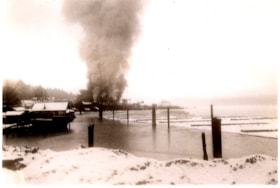
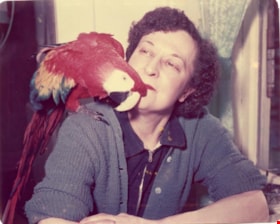
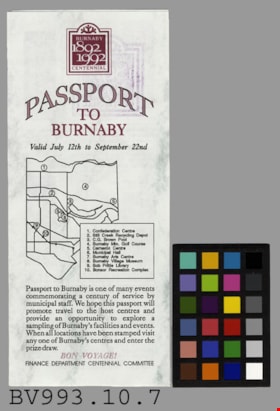
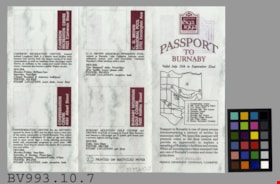
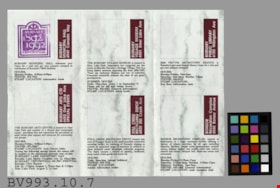
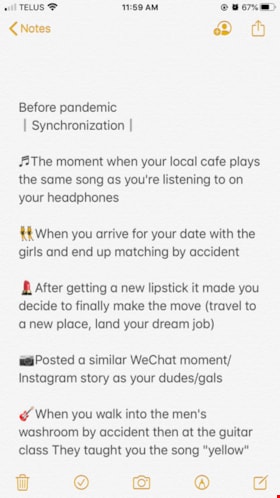
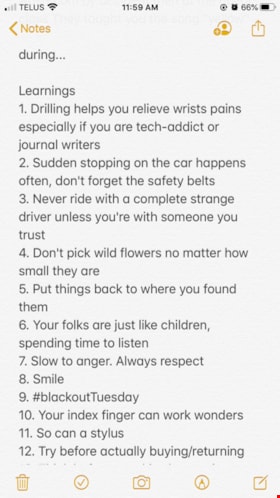
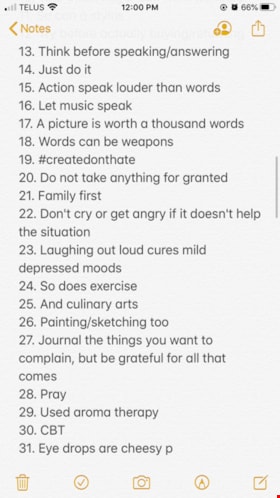
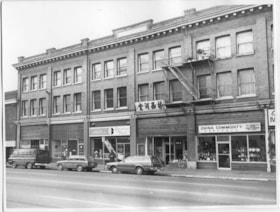
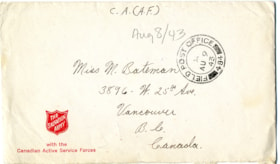
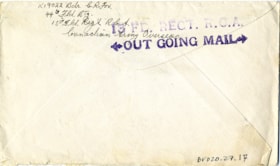
![Letter from Jesse Love to Dot Love, [1910] (date of original), photographed 1979 thumbnail](/media/hpo/_Data/_BVM_Images/1977/197900400004.jpg?width=280)
![Letter from Jesse Love to Dot Love, [1910] (date of original), photographed 1979 thumbnail](/media/hpo/_Data/_BVM_Images/1977/197900400005.jpg?width=280)
![Man at saw, [194-] (date of original), copied 2004 thumbnail](/media/hpo/_Data/_BVM_Images/2019/2019_0032_0021_001.jpg?width=280)
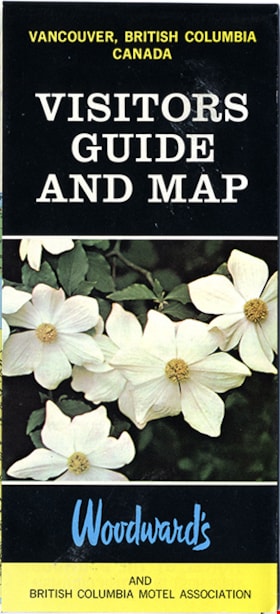
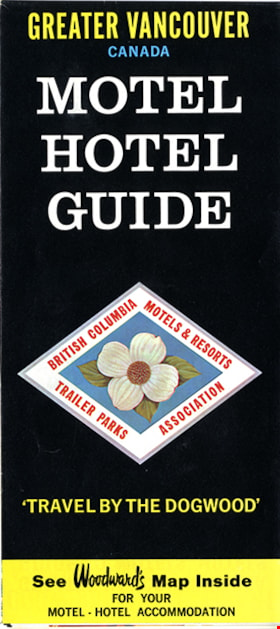

![Mayo Manhas and Kapoor Singh Siddoo in mill office, [194-] (date of original), copied 2004 thumbnail](/media/hpo/_Data/_BVM_Images/2019/2019_0032_0003_001.jpg?width=280)
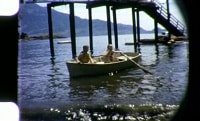
![Men on green chain, [194-] (date of original), copied 2004 thumbnail](/media/hpo/_Data/_BVM_Images/2019/2019_0032_0022_001.jpg?width=280)
![Millwright sharpens saw blade, [194-] (date of original), copied 2004 thumbnail](/media/hpo/_Data/_BVM_Images/2019/2019_0032_0020_001.jpg?width=280)

